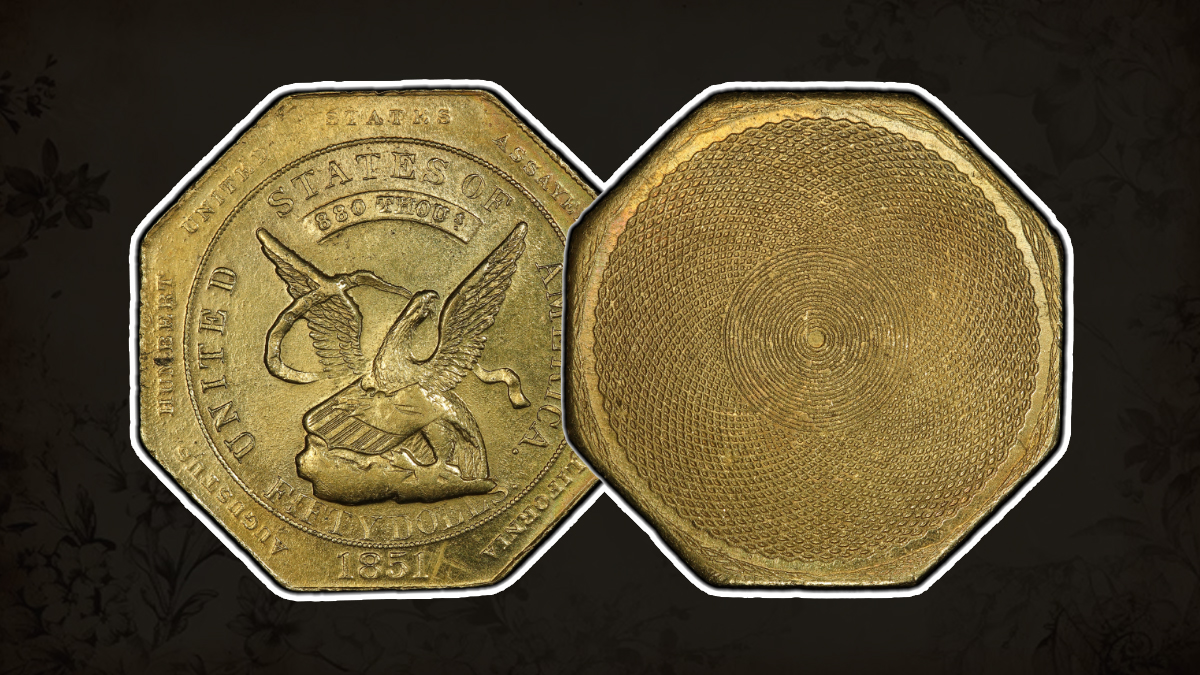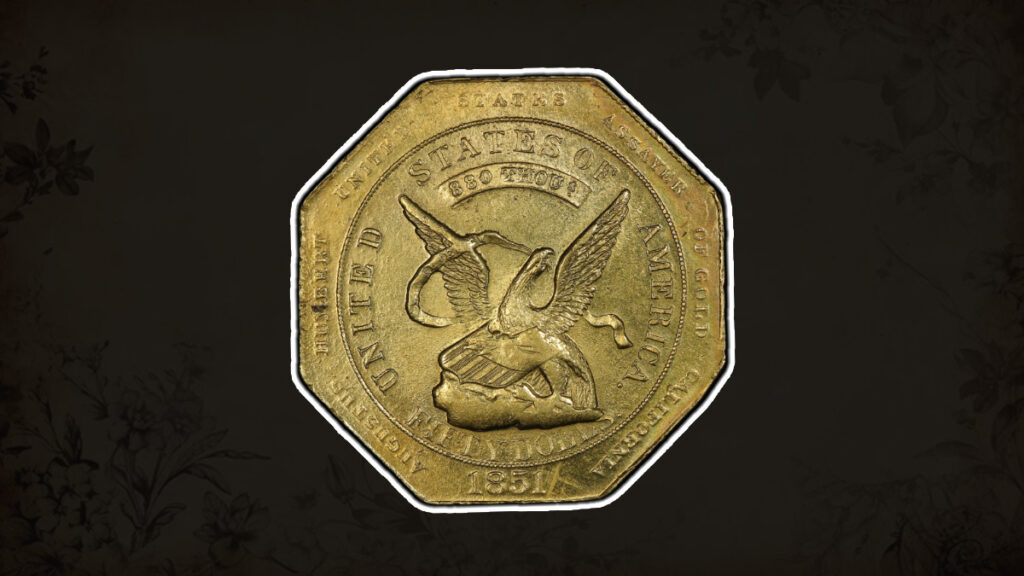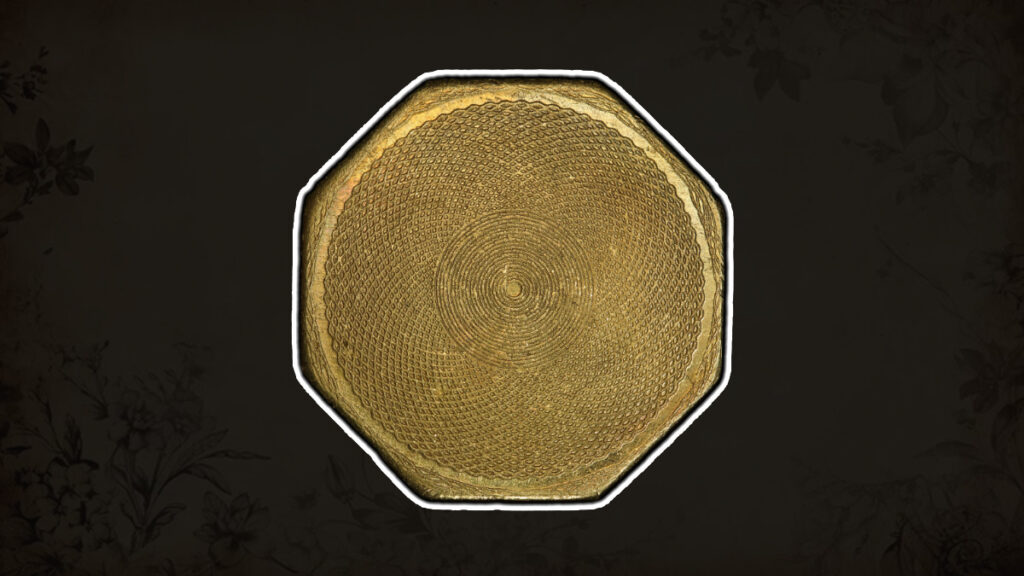
Few coins capture the excitement, drama, and spirit of the American Wild West quite like the 1851 Humbert $50 gold “slug.” These massive gold pieces are more than just coins—they’re historical artifacts, tangible links to the California Gold Rush, and the early days of San Francisco’s booming financial life. With their hefty size, rich gold content, and limited availability, they’ve always fascinated collectors and history buffs alike.
Now, Stack’s Bowers Galleries is giving collectors a rare opportunity to own one of these spectacular pieces. Coming up in their May 2025 Showcase Auction is a particularly noteworthy example: an 1851 Humbert $50 “Slug” graded MS62 by NGC, featuring the 880 THOUS., Target Reverse type with reeded edge (Kagin-5). This coin is one of the best-graded examples as well as to being an amazing piece of history.
The History of the $50 Gold Humbert “Slug”
In the era of the California Gold Rush in the early 1850s, the West desperately needed a reliable and secure currency of exchange. In the Californian hills, miners were making a lot of money, but the system was in mess since gold dust was the main form of payment. To bring back order, Augustus Humbert was sent to San Francisco as the U.S. Assayer of Gold.
Humbert struck these huge $50 gold “slugs” under the direction of the U.S. Assay Office of Gold. Although they weren’t given by the US Mint, these coins had a level of credibility and acceptance that made them widely used. The Humbert slugs were trusted by merchants and bankers, helping to stabilize the local economy.
What makes these coins truly remarkable is their story—struck in a frontier city teeming with gold and ambition, crafted by a man with a vision for bringing order to monetary chaos, and carrying a design that spoke of strength, security, and trust.
Historical Importance of the 1851 Gold “Slug”
The 1851 Humbert $50 “slug” played a vital role in California’s development during the Gold Rush. Gold was being dug out of the ground by the ton, and a reliable system was needed to turn that raw wealth into spendable money. The slugs solved that problem, offering a large, valuable, and trusted format that could be used for big transactions and banking.
Eventually, the U.S. government established a branch mint in San Francisco in 1854, and many of the Humbert slugs were melted down and recoined into official U.S. Mint products. This is one reason why these coins are so rare today. Most of them didn’t survive. Those that did are now relics of a time when gold ruled the West and money literally glittered in your hand.
Collectors value these coins not just for their rarity but for the story they tell. They mark the transition from a chaotic, dust-based economy to a more structured financial system, and they represent a key moment in U.S. monetary history.
Physical Features of the 1851 Humbert $50 Coin
The Humbert $50 “slug” is a monster of a coin. Weighing in at nearly 2.5 troy ounces of gold, it was one of the largest denominations of its time. Its octagonal shape immediately sets it apart from typical round coins, and its bold lettering and intricate design showcase a striking aesthetic.
One of the most recognizable types is the “880 THOUS.” Target Reverse, which refers to the fineness of the gold (880 thousandths pure) and the circular target-style design on the reverse side. These design choices weren’t just decorative—they were meant to reassure users of the coin’s authenticity and quality.
The reeded edge was another security feature, helping to prevent people from shaving off small amounts of gold (a common problem in those days). Every detail, from the legends to the weight indicators, reflects the care that went into making these slugs both functional and beautiful.
The 1851 Humbert $50 “Slug” in MS62 Grade
What makes the upcoming auction piece so exceptional is its condition. Most Humbert slugs show heavy wear—they were workhorse coins, used frequently and roughly. Finding one in Mint State condition (meaning it shows no signs of wear and only minor imperfections from the minting process) is incredibly rare.
The piece offered by Stack’s Bowers Galleries is graded MS62 by NGC, one of the most respected grading services in the world. According to their census, only three coins of this type exist at the MS62 level, and just one is known to be slightly better at MS62+.
Here’s how the Stack’s Bowers catalog describes it:
“Warm olive undertones backlight dominant medium honey-gold color, the surfaces lustrous with a lively frosty texture. Overall striking detail is exceptional, accuracy alone compelling us to mention the often-seen softness on the central obverse high points. We stress, however, that the peripheral legend on that side is legible in full, with each individual letter crisp.
The edges are remarkably smooth and free of the typically encountered large bumps and deep bruises. Also free of sizable surface marks, and while faint hairlines are present to explain the MS-62 grade from NGC, both the eye appeal and overall quality are exceptional for the type. This is an outstanding coin that combines absolute scarcity with condition rarity.”
It’s not just a beautiful coin—it’s one of the best of its kind.
Importance of Mint State Grading for Collectors

For coin collectors, the condition is everything. While rarity matters, the state of preservation often makes the difference between a good coin and an extraordinary one. That’s why Mint State (MS) graded coins are so desirable, especially when dealing with something as historically significant as the 1851 Humbert $50 gold slug.
A Mint State grade, especially MS62, indicates that the coin has never been in circulation. It means the piece is as close as possible to how it looked when it was first struck over 170 years ago. That’s remarkable for any coin from the 19th century, but for a large, heavily used coin like this one? It’s practically a miracle.
Collectors chase Mint State Humbert slugs not only for their eye appeal but for what they represent—a preserved moment in Gold Rush history. These are coins that were meant to be used, not stored or saved. So, when you find one that’s managed to avoid the wear and tear of time, it becomes more than a coin—it’s a time capsule.
The Kagin-5 Designation and Its Meaning
In numismatic circles, reference numbers are commonly utilized for categorizing and classifying certain coin kinds. The Kagin-5 designation for the 1851 Humbert $50 “slug” up for sale is an integral part of a unique system that distinguishes between the many Humbert coin variations.
The “Kagin” reference comes from the standard cataloging work by Donald H. Kagin, a leading expert in pioneer and territorial gold coins. The Kagin-5 designation helps collectors and experts identify exactly which type of Humbert slug they’re looking at—including design elements, edge styles, and inscriptions.
This special example, Kagin-5, features are:
- The “880 THOUS.” inscription indicates gold purity
- A “Target Reverse” design
- A reeded edge
Because of all these factors, Kagin-5 is one of the most popular and desired Humbert series types. For serious collectors, understanding these differences is important since a small design variation can have a big influence on rarity and value.
Stack’s Bowers May 2025 Showcase Auction Highlights

The May 2025 Showcase Auction of Stack’s Bowers Galleries, one of the top rare coin auction houses in the world, is looking to be a spectacular occasion. It’s a must-see for both investors and collectors, with about 375 items of outstanding numismatic gems.
At the heart of the auction is lot 11374—the MS62-graded 1851 Humbert $50 gold slug. But that’s not the only gem up for grabs. This auction is packed with rare U.S. and world coins, colonial pieces, early federal issues, and gold coins that span centuries.
Anyone may easily browse the pieces or take part in the auction because of Stack’s Bowers. Their website contains historical information, images, and detailed descriptions. Whether you are an experienced collector or a novice bidder, here is a great opportunity for finding some of the most unique coins ever minted.
How to View and Bid on This Rare Coin
Stack’s Bowers has made it simple and easy for anyone who wants to see this wonderful Humbert $50 “slug” for themselves or even make a bid. This lot and every other item in the May 2025 Showcase Auction are available to watch online at StacksBowers.com.
High-quality images, expert explanations, and complete grading information for every coin are all available there. You have the choice to bid live during the auction or register to bid online before. Those who want to beat the competition may take part in advance bidding.
Be ready to make a high price if you intend to bid on this MS62 Humbert slug. There will be strong competition because there are so few Mint State examples. For most collectors, however, it is a once-in-a-lifetime chance to have a coin of this grade.
Consignments Now Open for Future Auctions
Stack’s Bowers isn’t just about buying—they’re also actively accepting consignments for future auctions. If you own rare coins, paper money, or other numismatic treasures, now is a great time to consider consigning them.
They’re currently accepting consignments for the June 2025 Showcase Auction as well as their upcoming Summer Global Showcase Auction. Everything from evaluation to the last sale may be handled by their staff of expert numismatists.
You may contact Stack’s Bowers by call at 800-458-4646 or via email at Consign@StacksBowers.com to start the process. They provide expert service, worldwide visibility, and a network of eager buyers ready to compete for your treasures, whatever how many rare coins you own.
Why the Humbert $50 “Slug” Stands Out Among Pioneer Gold
The Humbert $50 “slug” from 1851 is one of the most famous pioneer gold issues from the middle of the 1800s. Its historical importance is what makes it outstanding rather than its size or gold content. These coins were made at an innovative, determined, and unreliable period in American economic history.
During the Gold Rush, a number private mints minted coins, only few have the power and influence of the US Assay Office. The coins weren’t legal currency at the time, but Augustus Humbert, the designated U.S. Assayer, had the support of federal authorities. Humbert’s works were given validity that other pioneers refers to did not have because of their semi-official status.Also, the slugs have a unique look.
The coin has a strong presence due to its octagonal design, detailed etching, and popular inscriptions like “880 THOUS.” The Humbert $50 slug is greater, rarer, and more historically important than other territorial gold pieces. In a single, plated package, it represents the union of official order with frontier roughness.
Collector Demand and Investment Potential
Rare coins have always appealed to collectors, but in recent years, they’ve also gained traction as alternative investments. The 1851 Humbert $50 “slug,” especially in Mint State condition, ticks all the boxes that investors look for: rarity, historical significance, aesthetic appeal, and a strong track record in auctions.
With only a few surviving examples in top grades like MS62, these coins often spark intense bidding wars. High-grade pieces command six-figure prices, and their value tends to appreciate over time, particularly as collector demand continues to grow.
This specific example, with its strong eye appeal and limited peer group (only three in MS62 and one finer), is likely to draw serious interest from seasoned collectors and savvy investors alike. It’s more than just a coin—it’s a tangible asset with both financial and historical value. As more investors look for hard assets outside of traditional markets, rare coins like this one are becoming increasingly sought after.
How Condition Rarity Elevates This Coin’s Status
Condition rarity refers to how uncommon a coin is in top condition, regardless of how many were originally minted. In the case of the Humbert $50 slug, very few examples were saved in pristine state. Most saw heavy use in a rough-and-tumble economy where coins were valued more for their metal than their minting.
That’s why this MS62-graded example stands out so dramatically. Out of all the 1851 Humbert slugs ever produced, only a tiny fraction exist in Mint State. And even fewer offer the balance of visual quality, luster, and historical clarity that this piece delivers.
It’s not just that the coin is rare—it’s that a coin this large, this old, and this heavily used still exists in such a clean, original state. It tells a story not just of gold and commerce, but of preservation against the odds. For collectors, that’s the kind of story worth investing in.
The Role of Stack’s Bowers in Preserving Numismatic History
Stack’s Bowers Galleries has long been a steward of numismatic heritage. With decades of experience, they’ve handled some of the rarest and most important coins in history, and their auctions are renowned for their professionalism and integrity.
By offering treasures like the MS62 1851 Humbert $50 slug, Stack’s Bowers continues to elevate the hobby and preserve American history in the process. Their detailed cataloging, high-resolution imaging, and historical context make each lot more than just a sale—it becomes a part of a living archive.
Collectors around the world rely on Stack’s Bowers not only to buy and sell, but to learn, connect, and engage with the history of money. And when they present something as iconic as the Humbert slug, the numismatic world pays attention.
Final Thoughts on This Iconic Piece of American History
Not only is the 1851 Humbert $50 “slug” gold, but it also has a history. It tells the story of a coin that became an essential part of frontier trade, in California during the Gold Rush, and Augustus Humbert’s attempts to keep demand in a successful, wild economy.
One of the best-recognized designs is now up for auction, more than 170 years later. This coin, which has been graded MS62 by NGC, is a unique relic from an important time in American history. It provides history buffs, investors, and collectors the chance to have a piece of the American story in their hands as well as to have the chance to find gold.
Visit Stack’s Bowers Galleries to learn more and make a bid on this one-of-a-kind historic. It provides a reminder that, whether you win the lot or just enjoy it from afar, coins can provide us the most visible connection to the past.
